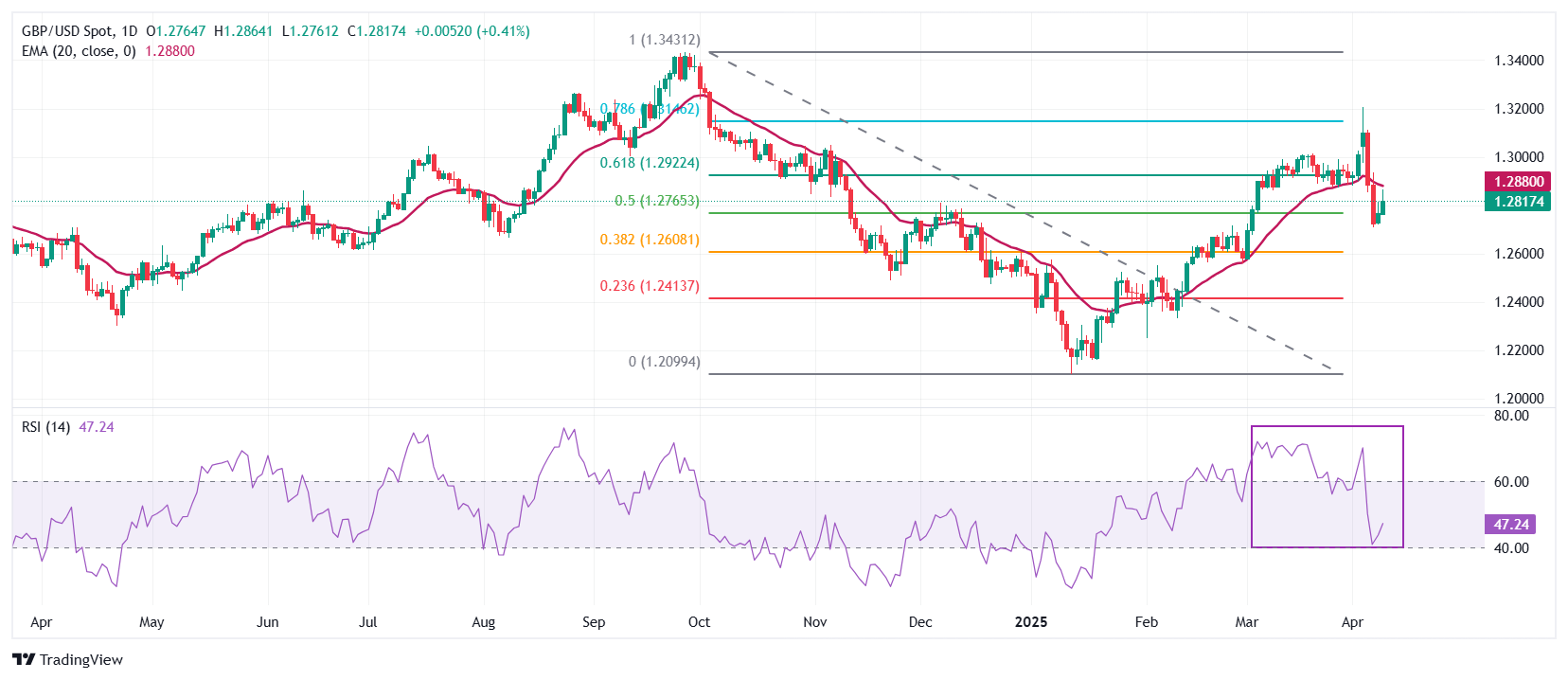- The Pound Sterling surrenders gains against the US Dollar as the British currency underperforms.
- US President Trump increased reciprocal tariffs on China to 104% against Beijing’s retaliation.
- Deutsche Bank expects the BoE to cut interest rates by 50 bps in May.
The Pound Sterling (GBP) tumbles against its major peers on Wednesday. The British currency faces a sharp selling pressure as the Bank of England's (BoE) Financial Policy Committee (FPC) has warned that a major shift in global trading arrangements could harm "financial stability by depressing growth".
The imposition of protectionist policies by United States (US) President Trump has stemmed the risks of a global recession. Analysts at JPMorgan believe the rapid escalation with US tariffs on China is disruptive enough to push the global economy into a recession.
China is known as the world’s manufacturing hub, given its competitive advantage in labor cost and supportive government policies. Financial market participants worry that Chinese firms will look for other markets to sell their products if its trade war with the US brews further. Such a scenario will be unfavorable for the United Kingdom (UK) economy as it seems incapable of battling a price war against China.
Meanwhile, traders have raised BoE dovish bets amid fears that Trump’s tariff policy could send shockwaves through the UK economy. Analysts at Deutsche Bank expect that the BoE may consider a more "forceful" response to current economic conditions and deliver a larger-than-usual interest rate cut of 50 basis points (bps) in the May policy meeting. The central bank identified a substantial decline in survey activity indicators, unwarranted tightening of financial conditions, and fears of labor market slowdown as key reasons behind the BoE’s ultra-dovish decision.
This week, investors will focus on the monthly Gross Domestic Product (GDP) and the factory data for February, which will be released on Friday. The UK economy is expected to have grown by 0.1% after contracting at a similar pace in January.
British Pound PRICE Today
The table below shows the percentage change of British Pound (GBP) against listed major currencies today. British Pound was the strongest against the US Dollar.
| USD | EUR | GBP | JPY | CAD | AUD | NZD | CHF | |
|---|---|---|---|---|---|---|---|---|
| USD | -0.82% | 0.02% | -0.99% | -0.72% | -1.27% | -0.67% | -1.09% | |
| EUR | 0.82% | 0.84% | -0.16% | 0.07% | -0.41% | 0.14% | -0.29% | |
| GBP | -0.02% | -0.84% | -1.02% | -0.74% | -1.25% | -0.69% | -1.12% | |
| JPY | 0.99% | 0.16% | 1.02% | 0.23% | -0.24% | 0.30% | -0.14% | |
| CAD | 0.72% | -0.07% | 0.74% | -0.23% | -0.39% | 0.06% | -0.37% | |
| AUD | 1.27% | 0.41% | 1.25% | 0.24% | 0.39% | 0.56% | 0.11% | |
| NZD | 0.67% | -0.14% | 0.69% | -0.30% | -0.06% | -0.56% | -0.44% | |
| CHF | 1.09% | 0.29% | 1.12% | 0.14% | 0.37% | -0.11% | 0.44% |
The heat map shows percentage changes of major currencies against each other. The base currency is picked from the left column, while the quote currency is picked from the top row. For example, if you pick the British Pound from the left column and move along the horizontal line to the US Dollar, the percentage change displayed in the box will represent GBP (base)/USD (quote).
Daily digest market movers: Pound Sterling surrenders gains against US Dollar
- The Pound Sterling gives up its entire intraday gains and turns flat to near 1.2765 against the US Dollar (USD) in Wednesday’s North American session. The GBP/USD pair falls back even though the US Dollar faces selling pressure amid firming expectations that the US could enter a recession this year. The US Dollar Index (DXY), which tracks the Greenback’s value against six major currencies, plummets to near 102.00.
- A fresh escalation in the trade war between the US and China has prompted risks of a recession in the US. During the European trading session, China announced additional 50% tariffs on the US over the 34% imposed last week, and all will become effective from April 10. Hefty import duties have been slapped by China on the US to match reciprocal tariffs increased by President Donald Trump on Tuesday. Trump raised reciprocal levies on Beijing for retaliation and currency manipulation to offset the impact of higher duties.
- Additionally, accelerating Federal Reserve (Fed) dovish bets due to increasing risks of a US recession have also weighed on the US Dollar. According to a CME FedWatch tool, traders are certain that the central bank will cut interest rates in the June meeting.
- For more cues on the monetary policy outlook, investors will focus on the Federal Open Market Committee (FOMC) minutes of the March policy meeting, which will be published at 18:00 GMT. In the policy meeting, the Fed left interest rates steady in the range of 4.25%-4.50%, and officials collectively maintained their guidance for two interest rate cuts this year.
- This week, investors will also focus on the US Consumer Price Index (CPI) data for March, which will be released on Thursday.
Technical Analysis: Pound Sterling remains below 20-day EMA

The Pound Sterling retreats to near 1.2765 against the US Dollar on Wednesday. The near-term outlook of the pair is bearish as it trades below the 20-day Exponential Moving Average (EMA), which trades around 1.2877.
The 14-day Relative Strength Index (RSI) rebounds after falling to near 40.00. A fresh bearish momentum could be triggered if the RSI fails to hold the 40.00 level.
Looking down, the 38.2% Fibonacci retracement plotted from late September high to mid-January low near 1.2610 will act as a key support zone for the pair. On the upside, the psychological figure of 1.3000 will act as a key resistance zone.
(This story was corrected at 10:07 GMT to say that the Federal Open Market Committee (FOMC) minutes of the March policy meeting will be published at 18:00 GMT, not 19:00 GMT.)
US-China Trade War FAQs
Generally speaking, a trade war is an economic conflict between two or more countries due to extreme protectionism on one end. It implies the creation of trade barriers, such as tariffs, which result in counter-barriers, escalating import costs, and hence the cost of living.
An economic conflict between the United States (US) and China began early in 2018, when President Donald Trump set trade barriers on China, claiming unfair commercial practices and intellectual property theft from the Asian giant. China took retaliatory action, imposing tariffs on multiple US goods, such as automobiles and soybeans. Tensions escalated until the two countries signed the US-China Phase One trade deal in January 2020. The agreement required structural reforms and other changes to China’s economic and trade regime and pretended to restore stability and trust between the two nations. However, the Coronavirus pandemic took the focus out of the conflict. Yet, it is worth mentioning that President Joe Biden, who took office after Trump, kept tariffs in place and even added some additional levies.
The return of Donald Trump to the White House as the 47th US President has sparked a fresh wave of tensions between the two countries. During the 2024 election campaign, Trump pledged to impose 60% tariffs on China once he returned to office, which he did on January 20, 2025. With Trump back, the US-China trade war is meant to resume where it was left, with tit-for-tat policies affecting the global economic landscape amid disruptions in global supply chains, resulting in a reduction in spending, particularly investment, and directly feeding into the Consumer Price Index inflation.
Information on these pages contains forward-looking statements that involve risks and uncertainties. Markets and instruments profiled on this page are for informational purposes only and should not in any way come across as a recommendation to buy or sell in these assets. You should do your own thorough research before making any investment decisions. FXStreet does not in any way guarantee that this information is free from mistakes, errors, or material misstatements. It also does not guarantee that this information is of a timely nature. Investing in Open Markets involves a great deal of risk, including the loss of all or a portion of your investment, as well as emotional distress. All risks, losses and costs associated with investing, including total loss of principal, are your responsibility. The views and opinions expressed in this article are those of the authors and do not necessarily reflect the official policy or position of FXStreet nor its advertisers. The author will not be held responsible for information that is found at the end of links posted on this page.
If not otherwise explicitly mentioned in the body of the article, at the time of writing, the author has no position in any stock mentioned in this article and no business relationship with any company mentioned. The author has not received compensation for writing this article, other than from FXStreet.
FXStreet and the author do not provide personalized recommendations. The author makes no representations as to the accuracy, completeness, or suitability of this information. FXStreet and the author will not be liable for any errors, omissions or any losses, injuries or damages arising from this information and its display or use. Errors and omissions excepted.
The author and FXStreet are not registered investment advisors and nothing in this article is intended to be investment advice.
Recommended content
Editors’ Picks

EUR/USD holds losses below 1.1400 ahead of ECB policy decision
EUR/USD stays on the back foot below 1.1400 in the European session on Thursday. The pair loses ground on the back of a broad US Dollar rebound and as traders remain cautious ahead of the European Central Bank interest rate decision and Lagarde's press conference.

GBP/USD stays defensive near 1.3250 as US Dollar bounces
GBP/USD stays defensive near 1.3250 in Thursday's European trading, snapping its seven-day winning streak. A tepid US Dollar recovery amid risk appetite prompts the pair to pullback from six-month highs of 1.3292 set on Wednesday. Traders look to tariff headlibnes and US data for fresh impetus.

Gold price retreats from record high as profit-taking kicks in
Gold price retreats after touching a fresh all-time peak earlier this Thursday and erodes a part of the previous day's blowout rally though the downside remains cushioned. A slight improvement in the global risk sentiment, bolstered by hopes of US trade negotiations, turns out to be a key factor undermining the precious metal.

European Central Bank set to cut interest rates again amid easing inflation and tariff uncertainty
The European Central Bank will announce its April interest rate decision on Thursday at 12:15 GMT. Markets widely expect the central bank to lower key rates for the sixth consecutive time. This time the ECB is set to deliver another 25 basis points (bps) cut after the April policy meeting.

Future-proofing portfolios: A playbook for tariff and recession risks
It does seem like we will be talking tariffs for a while. And if tariffs stay — in some shape or form — even after negotiations, we’ll likely be talking about recession too. Higher input costs, persistent inflation, and tighter monetary policy are already weighing on global growth.

The Best brokers to trade EUR/USD
SPONSORED Discover the top brokers for trading EUR/USD in 2025. Our list features brokers with competitive spreads, fast execution, and powerful platforms. Whether you're a beginner or an expert, find the right partner to navigate the dynamic Forex market.



